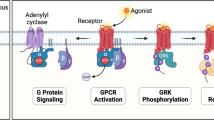Abstract
The recently cloned P2Y11 receptor is unique amongst P2Y receptors with its coupling to the adenylyl cyclase pathway. P2Y11 has previously been shown to be expressed in human acute promyelocytic leukemia (APL) HL-60 and NB4 cell lines, and both cell types elevate cyclic AMP (cAMP) levels upon stimulation with extracellular ATP. Acute erythroleukemic K562 cells and acute monocytic leukemia U937 cells did not elevate cAMP levels upon exposure to 1 mM extracellular ATP. However, K562 and U937 cells stably transfected with P2Y11 (K11 and U11 cells, respectively) were responsive to extracellular ATP, with an EC50 of 31 and 21 μM, respectively. The most potent agonists in both K11 and U11 cells were ATPγS (adenosine 5′-O-[3-thiotriphosphate]), ATPαS (adenosine 5′-O-[1-thiotriphosphate]), dATP and ADPβS (adenosine 5′-O-[2-thiobisphosphate]), which were of similar or greater potency compared to ATP itself. ADP and α,β-methylene ATP were less potent compared to ATP. The order of potency for ATP breakdown products was ATP > ADP > AMP ≥ Ado. UTP, a known activator of P2Y2 and P2Y4, was largely ineffective. In the transfected cells, ATP-induced cAMP elevation was inhibited by suramin (0.5 mM), but not XAC (20 μM) nor PPADS (100 μM). AMPS inhibited ATP-induced cAMP elevation in both K11 and U11 cells (EC50 ~ 3 mM) and may be a P2Y11-selective inhibitor. These results are similar to those observed for HL-60 cells and NB4 cells implicating P2Y11 as the receptor responsible for the ATP-induced cAMP elevations in these cells.
Similar content being viewed by others
References
Boarder MR, Weisman GA, Turner JT, Wilkinson GF: G protein-coupled P2 receptors: From molecular biology to functional responses. Trends Pharmacol Sci 16: 133-139, 1995
Harden TK, Boyer JL, Nicholas RA: P2-purinergic receptors: Sub-type associated signaling responses and structure. Annu Rev Pharmacol Toxicol 35: 541-579, 1995
Communi D, Govaerts C, Parmentier M, Boeynaems JM: Cloning of a human purinergic P2Y receptor coupled to phospholipase C and adenylyl cyclase. J Biol Chem 272: 31969-31973, 1997
van der Weyden L, Rakyan V, Luttrell BM, Morris MB, Conigrave AD: Extracellular ATP couples to cAMP generation and granulocytic differentiation in human NB4 promyelocytic leukemia cells. Immunol Cell Biol: 2000 (in press)
Berchtold S, Ogilvie ALJ, Bogdan C, Muhl-Zurbes P, Ogilvie A, Schuler G, Steinkasserer A: Human monocyte derived dendritic cells express functional P2X and P2Y receptors as well as ecto-nucleotidases. FEBS Lett 458: 424-428, 1999
Communi D, Robaye B, Boeynaems JM: Pharmacological characterization of the human P2Y11 receptor. Br J Pharmacol 128: 1199-1206, 1999
Jiang L, Foster FM, Ward P, Tasevski V, Luttrell BM, Conigrave AD: Extracellular ATP triggers cyclic AMP-dependent differentiation of HL-60 cells. Biochem Biophys Res Comm 232: 626-630, 1997
Choi SY, Kim KT: Extracellular ATP-stimulated increase of cytosolic cyclic AMP in HL-60 cells. Biochem Pharmacol 53: 429-432, 1997
Conigrave AD, Lee JY, van der Weyden L, Jiang L, Ward P, Tasevski V, Luttrell BM, Morris MB: Pharmacological profile of a novel cyclic AMP-linked P2 receptor on undifferentiated HL-60 leukemia cells. Br J Pharmacol 124: 1580-1585, 1998
Auffray C, Rougeon F: Purification of mouse immunoglobulin heavy-chain messenger RNAs from total myeloma tumor RNA. Eur J Biochem 107: 303-314, 1980
Bradbury RA, Sunn KL, Crossley M, Bai M, Brown EM, Delbridge L, Conigrave AD: Expression of the parathyroid Ca2+-sensing receptor in cytotrophoblasts from human term placenta. J Endocrinol 156: 425-430, 1998
Luttrell BM, Henniker AJ: Reaction coupling of chelation and antigen binding in the calcium ion-dependent antibody binding of cyclic AMP. J Biol Chem 266: 21626-21630, 1991
Jin J, Dasari VR, Sistare FD, Kunapuli SP: Distribution of P2Y receptor subtypes on haematopoietic cells. Br J Pharmacol 123: 789-794, 1998
Boyer JL, O'Tuel JW, Fischer B, Jacobson KA, Harden TK: Potent agonist action of 2-thioether derivatives of adenine nucleotides at adenylyl cyclase-linked P2Y-purinoreceptors. Br J Pharmacol 116: 2611-2616, 1995
Schachter JB, Boyer JL, Li Q, Nicholas RA, Harden TK: Fidelity in functional coupling of the rat P2Y1 receptor to phospholipase C. Br J Pharmacol 122: 1021-1024, 1997
Author information
Authors and Affiliations
Rights and permissions
About this article
Cite this article
van der Weyden, L., Adams, D.J., Luttrell, B.M. et al. Pharmacological characterisation of the P2Y11 receptor in stably transfected haematological cell lines. Mol Cell Biochem 213, 75–81 (2000). https://doi.org/10.1023/A:1007168215748
Issue Date:
DOI: https://doi.org/10.1023/A:1007168215748




